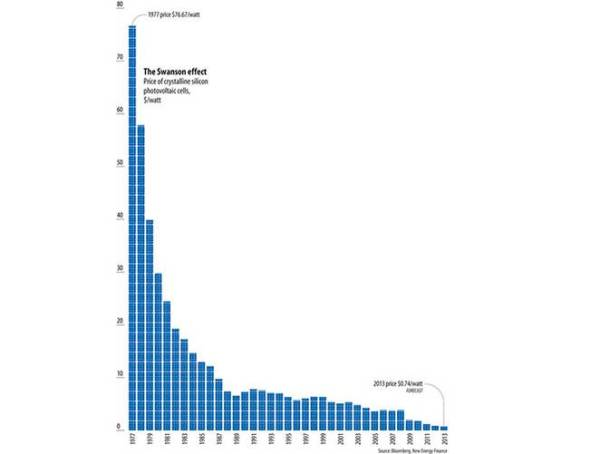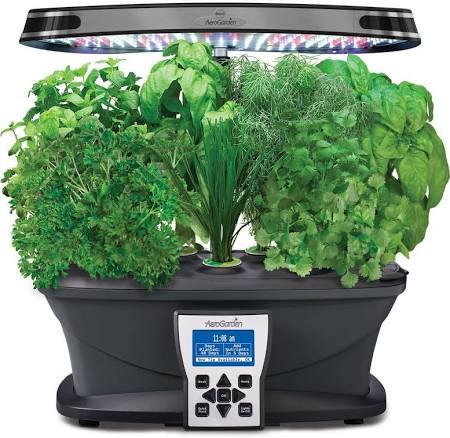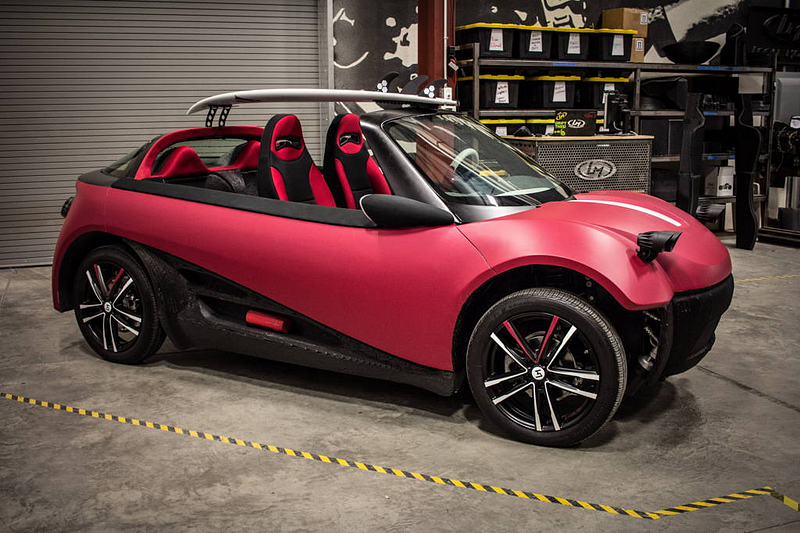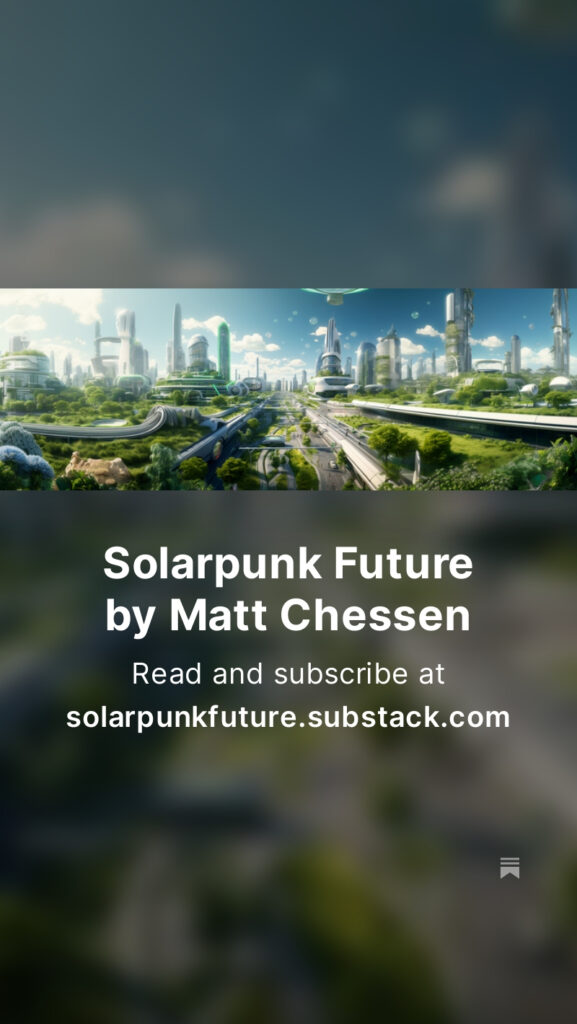
I have a theory that we are entering the era of ‘Peak Stuff,’ which I define as a local maximum in the amount of goods which are being transferred long distances around the globe. I don’t have large data sets supporting this proposition, but there are some interesting signs to watch. Call it an informed hunch. The evidence:
We’re probably going to move less oil.
This graph from Bloomberg shows the decline in the cost of solar panels from $76/watt in the 1970s to $0.57/watt in 2015.

As Bloomberg also reports, renewables are crushing fossil fuels. Solar and wind are now cheaper than new fossil fuel capacity in more than 30 countries. Combine that with new technologies like fracking, which could unlock huge gas supplies in energy importers like China and new widely located sources of energy, like methane hydrates, and you have to wonder who is going to be moving all that oil around.
Much more energy will be produced local to where it is consumed, and an increasing share of it will be renewable. (Aside from the environmental benefits, why are renewables awesome? Because the fuel is free. It’s a capitalist’s dream). That means less oil will be transiting the Earth. Crude oil accounts for approximately 25% of all goods transported by sea. Coal, petroleum products, natural gas and other fossil fuels are smaller, but significant fractions of global shipping tonnage. Peak oil is coming, but it’s not the doomsday collapse in supply everyone feared, it’s the collapse in demand, which is feared only by those with significant investments in oil infrastructure.
We’ll probably be moving a lot less oil the future.
We’re probably going to move less food.
My wife and I bought an Aero Garden. It’s a soilless garden that grows on your counter using LED lights, water and a nutrient mix. It was a big investment upfront, but it’s been an awesome purchase. We have a constant supply of fresh basil, oregano, mint and cilantro which taste considerably better than store bought herbs.

This got me wondering why entrepreneur farmers weren’t doing this on a massive scale in cities, using urban gardens to shorten the farm-to-market supply chain. To my surprise, they already are. Vertical farms are a thing, and they’re coming to a city near you. The economics are challenging, and there are numerous issues, but it’s hard to argue that vertical farming wont reduce the number of food miles in the future.

We’re also going to be farming from our ocean coastlines. The Greenwavemovement is focused on building new ocean coastal farming ecosystems which are healthy, profitable and sustainable. Greenwave is building a new, local agricultural economic model that is the inverse of industrial farming. Rather than shipping ocean catch halfway around the world, Greenwave products will be shipped to local community stores and restaurants, reducing the number of miles food has to travel from the ocean to your mouth.
And we’re going to grow our meat in vats, not in fields. Cultured meat is the future of protein. There are ethical, safety, environmental and resource conservation arguments for growing our meat in vats, but the economics aren’t there yet. Nevertheless, Dr. Mark Post, whose team created the first synthetic beef burger, believes cultured meat will be competitive with farmed meat within a decade. The great part about cultured meat is that you don’t have to make it on farmland. It’s an industrial process which can be located close to the population centers where the meat is consumed.
There are a lot of reasons to believe food is going to be moved less distance in the future.
We’re probably going to move fewer finished products.

Much has been written of the 3D printing (ie additive manufacturing) revolution, and the hype has outpaced the reality. But reality may be catching up. Local Motors can now print 75% of a new, custom automobile, and their goal is to print 90%. 3D printers can make a wide range of consumer junk that is now imported from overseas. Companies like Optomecare making 3D printers which can mass produce consumer electronics.
The point isn’t where we are now; it’s where we’re going. In the future, our long supply chains will be disrupted. Now, raw materials flow to manufacturing goliaths like China where they are assembled into finished goods and shipped back around the world. Soon, those raw materials will go directly to a Best Buy outlet or Amazon manufacturing plant near you, where they will feed 3D printers which create your goods on the spot. Very few items will be held in inventory and most will be assembled to order. Or AIs will predict what nearby populations want, and will assemble just enough to meet anticipated demand, enabling same day delivery for nearly anything.
Stuff will still move, but it will make one long trip as raw materials and one short one to your home, rather than two long trips each way. That means less stuff moving less distance.
Does this mean global trade will collapse?
No way! This thesis has a counterpart which is, as we move less stuff, we will move more data. The oceans were the major circulatory system of the pre-21st century economy. In the 20th century, air travel bolstered that system. These systems aren’t going away, but they will decline in relative importance. We are moving through a transition where the Internet will be the new primary circulatory system for international trade.
To illustrate, let’s take a piece of consumer electronics like a smart-phone. Now, raw materials flow all around the world to component manufacturers. Then those components flow to a country where they are assembled into a finished product. Then those smartphones flow all around the world to consumers who will use them.
In the future, raw materials will flow directly to regional or local additive manufacturing plants. They will print the smartphone, adding in any components which can’t yet be printed. Then the finished phones will be shipped a short distance to the end consumer. Consumers throughout the world will be serviced by the additive manufacturing plant nearest them.
This will shift the mix of who extracts profits from the system, but it maintains the system of global trade. Even better, it democratizes it. Anyone, anywhere will be able to create schematics for products and post them for sale online. You’ll buy a license for the product from the intellectual property creator and the schematic will be sent to a local 3D printing facility for assembly. The cost of the actual material inputs will be almost irrelevant — the value will be in the manufacturing recipes.
Someone, someday is going to create an ‘app store’ for selling and assembling 3D printed goods, and they’re going to make a lot of money doing it (when you do, please remember the guy who gave you the idea :)). The future will look a lot more like Etsy — where you’re buying custom products from the general public — than WalMart, where you buy mass produced stuff where the production is determined by corporate executives who think they know what you want.
Peak Stuff
We’re going to be moving less stuff around the world, and the stuff that does move will travel fewer miles. I predict peak stuff will happen sometime in the next decade.
What do you think? Will we hit peak stuff? And what will it mean for the world when we do?
Tags: 3d printing, additive manufacturing, oil, peak stuff, synthetic meat, vertical farming


Are you aware of seawater greenhouse production? Our project planned for Israel can develop tremendous green house production in the Arava. Research Dead Sea Power Project
A handwritten book is a book
(palimpsests). In the XIII-XV centuries in
… As a rule, the manuscript is called
only a few survived.
book about the chess of love “, created by
book about the chess of love “, created by
(palimpsests). In the XIII-XV centuries in
Since the era of Charlemagne
Since the era of Charlemagne
from lat. manus – “hand” and scribo – “I write”) ]
Western Europe also formed
from lat. manus – “hand” and scribo – “I write”) ]
European glory, and even after
“Julia’s Garland” (fr. Guirlande de Julie)
from lat. manus – “hand” and scribo – “I write”) ]
among them acquired “Moral
Western Europe also formed
Century to a kind of destruction:
Since the era of Charlemagne
among them acquired “Moral
Europe, and in Ancient Russia